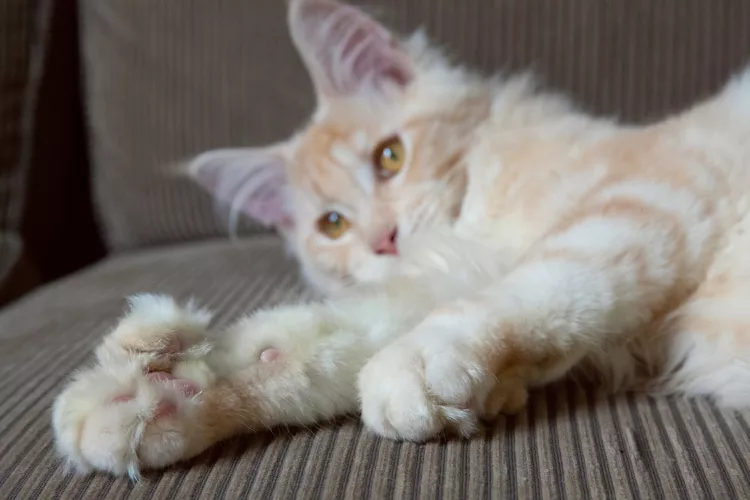- 01 of 07
Polydactyly Is Caused by a Genetic Mutation
Polydactyly is caused by a genetic mutation in a dominant gene and usually results in the formation of anywhere between four to seven toes on a kitty’s paws. The front paws are most often affected by polydactyly, but it can also occur on the hind paws. However, it’s rare for a cat to have polydactyly on all four paws. There are actually three types of polydactyl paws seen in cats.
- Postaxial: Extra toes are on the outside of the paw
- Preaxial: Extra toes are on the inside (medial aspect) of the paw
- Mesoaxial: Extra toes are throughout the paw (may look like a combination of postaxial and preaxial)
For the most part, polydactyly is harmless to a cat’s health and wellness. It can make trimming your cat’s nails a bit more labor-intensive—and if you’ve ever trimmed your cat’s nails, you know how difficult it is—but otherwise, there are plenty of happy, healthy kitties with a few extra toes.
It’s important to note that feline radial hypoplasia, a condition that is often confused with polydactyly, can be extremely detrimental to a cat’s health. Like polydactyly, feline radial hypoplasia causes the development of extra toes. The major difference is that the extra toes develop immediately next to the cat’s normal toes, resulting in extremely large, flat feet. If cats with feline radial hypoplasia are bred, it can cause severe paw deformities in subsequent generations.
Continue to 2 of 7 below - 02 of 07
Some Polydactyl Cats Have “Mittens”
“Mitten paws” occur in preaxial polydactyl cats. This is when the cat’s extra toes form in the middle of the paw, giving it a thumb-like—or mitten-like—appearance. Although these extra digits resemble thumbs, they aren’t opposable.
Continue to 3 of 7 below - 03 of 07
Polydactyly Can Actually Benefit Some Cats
Polydactyl cats’ toes aren’t just cute—they provide some benefits to kitties, too. Because polydactyl cats have wider, larger paws, they’re better able to balance on various surfaces, climb, hunt, and capture their prey.
If you have a polydactyl cat, be sure to get a scratching post or board and make sure that nail trims account for all their toes. Those extra toes and claws can seriously do a number on your furniture.
Continue to 4 of 7 below - 04 of 07
Polydactyl Cats Are Considered Lucky
Like many kinds of cats (black cats and calico cats included) that were believed to bring good luck to sailors, polydactyl cats are no exception. Back in the day, polydactyl cats were a common sight on long journeys by ship.
With the help of their large, wide paws, polydactyl cats made excellent mousers and could keep the ship’s supplies vermin-free. Plus, their paws helped them balance on rocky seas.
Polydactyl cats are most commonly found in Western England, Wales, Canada, and the Eastern United States, and their prevalence in those regions is often credited to their days on trans-continental ships. It’s believed that polydactyl cats in England were transported across the Atlantic Ocean where they mated with non-polydactyl cats and proliferated the genetic trait.
Continue to 5 of 7 below - 05 of 07
Ernest Hemingway Loved Polydactyl Cats
Have you ever wondered why polydactyl cats are sometimes referred to as Hemingway cats? Well, it’s because Ernest Hemingway loved them. After he was gifted a white, polydactyl cat named Snow Ball by a ship’s captain, Ernest Hemingway developed a serious affection for these multi-toed kitties.
After his death in 1961, his home in Key West, Florida was transformed into a museum and a home for his beloved cats. Currently, the kitty colony is home to about 50 descendants of his original pack of cats, and about half of them are polydactyl.
Continue to 6 of 7 below - 06 of 07
The Condition Was Very Common Among Maine Coon Cats
Because Maine coon cats originated in Maine’s harsh, snowy conditions, they’ve evolved to have large, insulated paws that serve as tiny, built-in snow boots. And, lucky for Maine coons, polydactyly was very common in the breed. At one time about 40 percent of Maine coons had extra digits. Why's it lucky? Polydactyly gave Maine coons larger, wider paws with more insulation to traverse the snowy conditions.
Today, polydactyly has been bred out of many Maine coon cats, but the polydactyl Maine coon is still recognized as a breed by some cat fanciers.
Continue to 7 of 7 below - 07 of 07
One Cat Holds the World Record for Most Toes
According to the Guinness Book of World Records, a polydactyl ginger tabby named Jake holds the world record for the most toes. Clocking in at a whopping 28 toes, Jake had seven toes on each paw—with each toe having its own claw, pad, and bone structure.
-
Are polydactyl cats rare?
Polydactyl cats are not rare are all. In fact, they're very common.
-
How long do polydactyl cats live?
Polydactyl cats live long as regular cats, about 15 years.
-
Are polydactyl cats a problem?
Polydactyl cats can generally live normal, healthy lives and rarely develop health issues or discomfort. However, toes without proper bone structure may hang loose, which may cause the nails to get caught and lead to injuries. This is why it's important to make sure you get all the toes when trimming nails.
-
How much are polydactyl cats worth?
Polydactyl cats aren't worth more than regular cats, unless they are also purebred.




















